January 2011 was the 8 year anniversary of the dinner club . We had agreed to do something epic in December 2010: eat in a metro train. On Sunday January 16th, we met at 7:30 pm on the passage over-looking the metro tracks at Côte-Vertu metro. Everyone had backpacks with food, utensils and […]
January 2011 was the 8 year anniversary of the dinner club . We had agreed to do something epic in December 2010: eat in a metro train. On Sunday January 16th, we met at 7:30 pm on the passage over-looking the metro tracks at Côte-Vertu metro. Everyone had backpacks with food, utensils and dishes. Some carried folding chairs, Judith a folding table and I had a table-cloth and adhesive Velcro. As the first members arrived, the anticipation of watching the trains below come and go and waiting for the other members created an electric buzz. By the time I got there, and I was one of the last ones, the buzz was popping out of peoples’ eyes. Voices were shrill yet restrained and giggles were many.
Once all of the illustrious members minus one had arrived, we verified the hour- right on time- and gave the signal- “go, go” . We shuffled down the stairs to the platform over-excited, and whispering. The train was waiting as Cote-Vertu is a terminus. Direction Montmorency- yes, we were riding all the way into that other world of Laval! But which wagon to get into? We consulted in a giddy panic…The second to last. We crashed in and then took stock of the surroundings two blasé solo riders. The beep announcing departure sounded and the doors closed. “Go-go!” We set up a table between the metro seats and some folding chairs. I covered the table with a retro table-cloth and we starts putting velcro on the bottoms of plastic plates and glasses and fastening them to the table-cloth. By the time we had gotten to Namur- we were ready to eat!
The theme of the meal, customized to eating in the metro in January was: food that boosts the immune system. We started with squash soup and banana bread. The first passengers were divided between gaping at us in awe and doing everything to not gape at us in awe, but when we got to Snowdon a lot of people came in. We didn’t expect so many for a Sunday evening. We shared the experience and sheer joy- giving banana bread to the passengers. Downtown we started serving lentil salad and the wagon was packed! People were freaking-out (in a good way): loving the reclaiming of public space, eating the food and taking tons of photos and giving us praise for the bold move. We watched in euphoria citizens with gaping mouths staring at us as we passed through the stations or peoples’ shock when they got in the train and looked up out of their daze to see us.
(Thanks to Eric Hansen for the video montage)
We started serving the meal around Berri: 40 garlic clove chicken and ginger roasted vegetables, accompanied by pungent condiments to ward off the germs: delicious!. After we got through downtown, dinner was quieter and we started to feel at home in our wagon. We ate peacefully- yet always interacting with our surroundings. As we approached Laval, we judged that we wouldn’t have time to eat dessert, so we packed up, got out at Laval and ate dessert on the way back. Dessert was apples stuffed with dried fruit, ginger and spices and baked in a crust and served with spiced apple cider. This was a nice ending. We quietly packed up and got out at Berri to go have a beer and do some kind of de-briefing.
The dinner club’s eight year anniversary was special because we proved you could do dinner club anywhere or anyhow you liked. We had inspired ourselves- we were gutsy, creative and we proved that the barriers that people experience are usually self-imposed or imagined. The passengers were as ecstatic as we were and the only STM employee we saw took a photo of us with his cell phone and gave us a thumbs up.
We shared our way of getting down each month and some of the food that was made with love by our members. We also made the public space one of interaction and expression, for at least that night. The experience got people out of their shells; it got them away from their concentrated floor, wall and book gazing and got them people watching. We also put on display and celebration the bonds we’ve forged through cooking and eating together for eight years.
Topping the eight year anniversary this year is going to be a challenge. If you have any larger than life quirky ideas or themes, please send them in. We are open and willing. The best idea will probably be nested until the ten year anniversary in 2013!

Private Members in the Public Space
The dinner club’s canning session was a success, but we also decided to do the first fermenting session. I took on the task of fermenting the cabbage, beets and kale as we couldn’t really spend 6 weeks together watching the process. I made real sauerkraut with the cabbage and did the […]

So much cabbage, so little time
The dinner club’s canning session was a success, but we also decided to do the first fermenting session. I took on the task of fermenting the cabbage, beets and kale as we couldn’t really spend 6 weeks together watching the process. I made real sauerkraut with the cabbage and did the same thing with the beets. For the kale, I made kimchi.

Kale Kimchi, Sauerkraut and beet sauerkraut
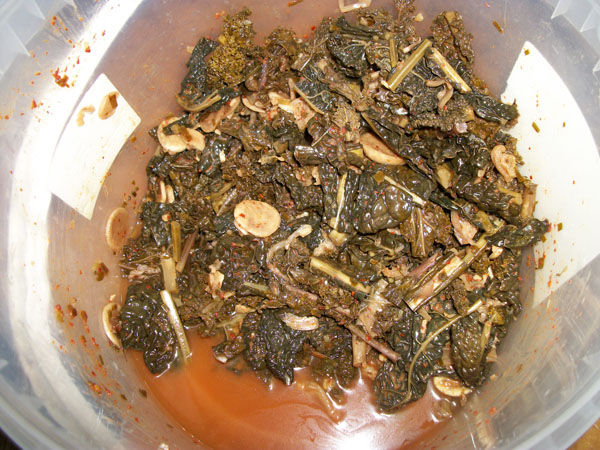
Kale Kimchi - The New Kimchi
Sauerkraut was first recorded by the Romans but came from the Orient. The method, however, was lost in Europe, but then re-introduced in Austria in the 13th century by the Tartar hordes, who had acquired it from China.

No those are not oompa loompas- they're life-size Germans in a celestial-size bucket of sauerkraut making sauerkraut in...a sauerkraut factory! This is from Time Life's Book about "The Cooking of Germany" (1969)
Sauerkraut is old, and fermentation older. Fermentation helps digestion, it preserves nutrients and food and produces delicious and pungent results. Doing it yourself doubly preserves the vitamins and beneficial live cultures that result from fermentation, as when store-bought, products are often pasteurized (heated to high enough temperatures to kill the good stuff). Micro biodiversity also gives our immune-system the challenges it needs to come up with more complex solutions, ie, live cultures keep our immune-system on its toes and in-shape.

Beet and cabbage sauerkraut veiling their most sensual trait- their microbiodiversity.
Here are the instructions for straight-up sauerkraut made with cabbage or beets, fast sauerkraut (the cheater way, not as nutritious, but still delicious), a sauerkraut soup recipe, my great Grandma’s sauerkraut salad recipe, British pickled cabbage, and, lastly, a video I made explaining how to make kale kimchi.
Sauerkraut
3 tbsp of salt per 2 kg of cabbage (you could also use beets, carrots or other root vegetables)
You will also need:
a container to put it in
a plate that fits snugly in the container
Something to weight it
A Tea towel
A Sterilized or well-scrubbed weight (A big jar of something)

Mandolin to shred, salt to preserve, cabbage for vitamin C
Shred the cabbage, put it in a food safe, non-reactive receptacle with the salt. Put the plate on top, weight it and cover it with a tea towel. After 24 hours add enough salt water (1 tbps of salt for 1 cup of water) to cover the plate. The brine keeps the kraut from the air and spoilage. Check every few days and skim off the “bloom” (usually mold).
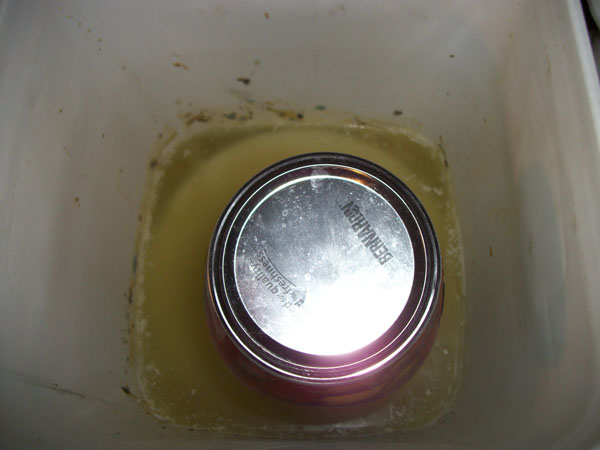
Sauerkraut weighted and in brine with a bit of "bloom".
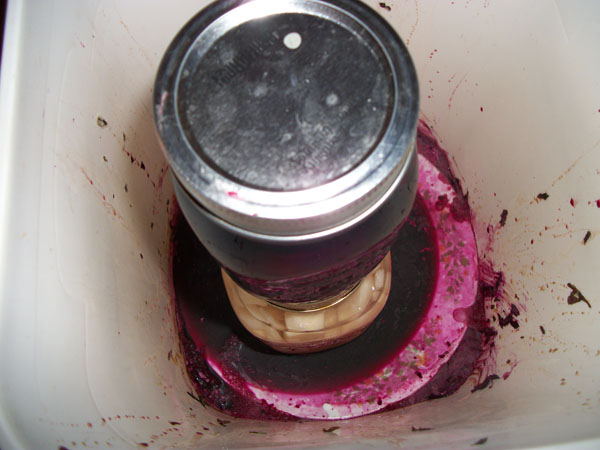
Beet sauerkraut- exactly the same process. I highly recommend Sandor Ellix Katz's Wild Fermentation on the subject of fermentation.
Cheater Sauerkraut

Fast sauerkraut- Just about like the real thing
If you’re not up for 6 weeks of fermenting cabbage, this is the cheater way. You will not get the health benefits, but it will still taste really good.
1 onion, cut in half and then finely sliced
1 head of green cabbage, shredded
2 tbsp of salt
1 c. of cider vinegar
1/2 c. of cider, beer, or white wine
1 tsp of caraway seeds
Mix the cabbage and onion with the salt and let it sit covered for at least 2 hours, up to 24 hours. Drain. Put in a pot and simmer 45 min.

This one was made with beer, but I like it even better with cider
Sauerkraut Soup Recipe
This recipe was sent to me by Melissa Denecke in Germany, who is a member of two dinner clubs in Germany! I met her on a cycling tour of Montreal with Fitz & Follwell. The soup is very original and surprising. Although I don’t have the food porn to convince you, I really recommend you try it.
300g of sauerkraut
1 onion, finely chopped
1 tbsp of butter
1 small can of mandarin oranges and its juice (I used fresh mandarins and 2 tbsp of freshly squeezed lemon juice)
500 ml of chicken stock
salt
pepper
1 tsp of dried ginger (I used 1 tbsp of fresh ginger)
1 tbsp of honey
300g of crème fraîche (or you can use a mix of cream and sour cream)
Sauté the onion with the butter until soft. Add everything but the crème fraîche. Simmer on low heat for 45 min. Add the crème fraîche and purée with a hand mixer.

The photo is very non-chalant, but this soup isn't! It's very unique, and provides an unearthy sensation
Sauerkraut Salad
I worked as a cook in a tree-planting camp in the summer of 2010. It turns out that my Great Grandma Elsa Lamarr was a logging camp cook for many years and this was one of her recipes.
A 1 kg jar of sauerkraut, rinsed
1/2 c. of chopped celery
1/2 c. of chopped peppers
1 c. of chopped onions
1 c. of honey (I use 1/2 c.)
1 c. of vinegar (I use 1/2 c. of cider vinegar)
salt and pepper

Rinsing the sauerkraut gets some of the the salt and acidity out
Combine all of the ingredients and let it marinate at least 45 min before serving. This is really good with a hot dog.
Pickled Cabbage
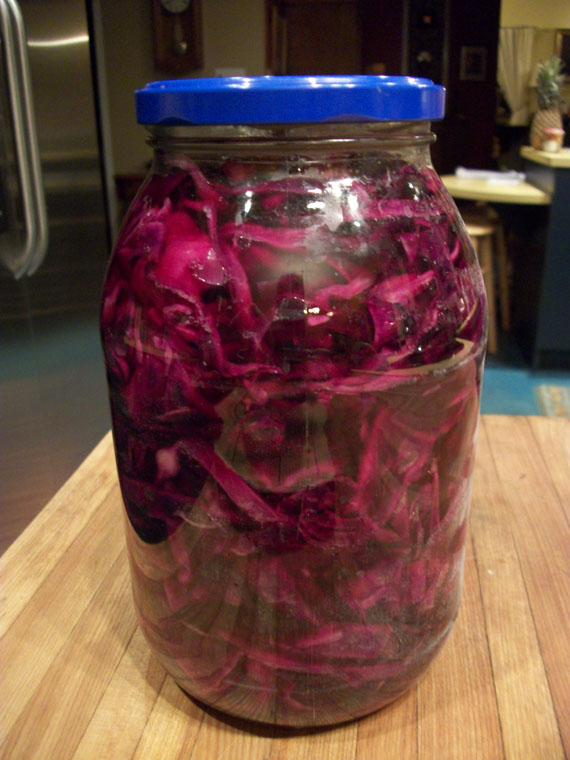
Canned Pickled Red Cabbage
This is yet another fast way to conserve cabbage. It is delicious. You can serve it with a roast, fish, or use it as you would sauerkraut. It is a British recipe, but I put a lot more water to make more of a vinegar brine than a straight-up vinegar marinade. Do it as you prefer.
2 red cabbages (about 3kg), shredded
6 tbsp of coarse salt
1 L of malt vinegar (I use 500ml of malt vinegar and 500ml of water)
1/4 c. of sugar
2 tbsp of pickling spice (Here I also improvise, using a variety of seeds and herbs: coriander, cumin, dried chilies, juniper berries, whole all-spice, mustard seeds, peppercorns, bay leaves)
Arrange the cabbage in three layers in a non-reactive container, putting 2 tbsp of salt between each layer. Cover it and let it sit for 2 days, stirring it a few times each day.

Salting the layers of cabbage
On the third day, combine the marinade ingredients in a saucepan and bring to a boil. Boil briskly for 5 min. Meanwhile, drain the cabbage. Put the cabbage in sterilized jars. Strain the marinade or leave the spices in if you like the look of it in the jars. Pour the hot marinade over the cabbage and close the jars. Wait at least 3 days before eating.

Pickling liquid- make it more vinaigary or less and use the spices you fancy, but please keep the malt vinegar.
One more idea….

Pineapple sauerkraut!

Rinse your cabbage and simmer it with pineapple juice for about 2 hours

Add pineapple in before serving
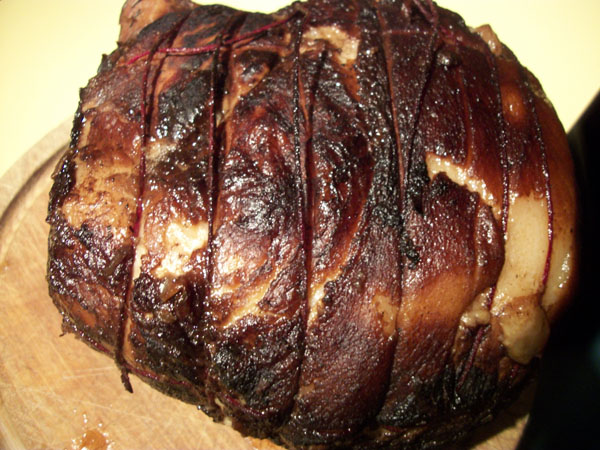
Pinepple sauerkraut is delicious with...a homemade ham!

Brine the ham with red wine, salt and spices, zest, fresh ginger for 3 days

Strain the brine mix, sear the ham, and then braise at a low temperature in the strained liquid for a few hours.
Enjoy the pineapple sauerkraut and ham your-style.
Kale Kimchi

Kale Porn Picture - See video below for unsexy clinical instructions

After salt- Dripping with sweat- More kale porn- please consult video
Just as a side note – I’m a lot spunkier than that in real life, but I was nervous. It was my first experience on film, and it was for a contest to win a trip to Korea. I was trying to look really Canadian with my sweater, but I just made Canadians seem really awkward….Enjoy! The video is below:
In Quebec the tourtière keeps its noble place on tables during the Réveillon or Christmas Eve. My family, which left Quebec 30 years ago for British Columbia still eats tourtière at Christmas too. If you do not know what the tourtière is, for many it is a meat pie with or without potatoes, […]

Tourtières fresh out of the oven- meat pie style
In Quebec the tourtière keeps its noble place on tables during the Réveillon or Christmas Eve. My family, which left Quebec 30 years ago for British Columbia still eats tourtière at Christmas too. If you do not know what the tourtière is, for many it is a meat pie with or without potatoes, but in Lac-St-Jean and Gaspésie it is a deep dish mix of meats covered with dough.
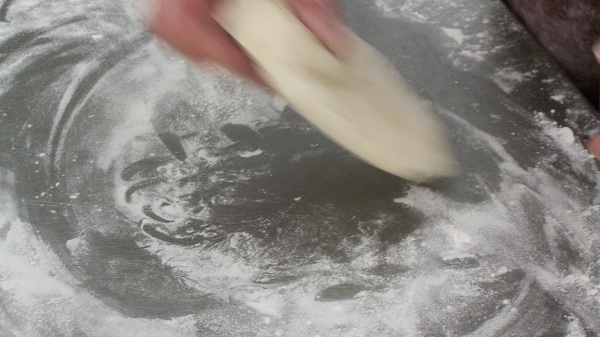
Scraping dough off the table
On November 20th I went to Aux Purs Délices the pastry shop on Church Street in Verdun to participate in the Réseau d’Entraide de Verdun bi-annual tourtière making day. Mr. L’Anglais generously leaves us his bakery and supplies with the boxes, aluminum pie trays, the use of his ovens and rolling pins to make the pies. The tourtière are sold for $3.00 each and are very popular at Christmas time. We make tourtières to fund my cooking workshops amongst other activities. Making them is a lively gig where one group of volunteers does the morning shift and another group the afternoon shift. The volunteers are put in different modes of production: most roll tops and bottoms, while others fill the pies, cover them, cut an “X” and brush the tops with egg wash, and others still fill the speed rack and the ovens. We get to taste the shop’s delicious pastries. The radio plays and we sing along with music from the 70’s and 80’s. You will hear comments like “C’est Richard Seguin qui chante ça. J’y ferais pas mal. Je passerai mes mains dans ses cheveux.” There’s a lot of fooling around, but we also manage to pump out about 400 tourtière’s in a day thanks to the energy of the volunteers, the rotating oven that fits 72 tourtière s at a time and because of the sheer love for tourtière.

- Production at Aux Purs Delices

Working the dough
While I was doing research for a contract the same week, I stumbled on “The Long History of Tourtière of Quebec’s Lac-St-Jean” by Jean-Pierre Lemasson in What’s to Eat: Entrées in Canadian Food History, Edited by Nathalie Cooke. It turns out that tourtière may have come from tourterelle or turtle dove pie. It may also have come from the name of the dish tourtière that it was cooked in, but the first recorded tourtière -like recipe dates back to 1600 B.C. Mesopotamia. It instructs to boil gizzards and intestines with aromatic bark, salt, fat and rue. It uses onion, samidu (an unknown spice from Mesopotamia), leek, garlic, sasku semolina and milk for the dough, and of course, poultry.
In 400 AD there is a version made with tripe, lovage, eggs and wheat flour.
There is also the Cipaille or Cipâte in Gaspésie whose ancestors are the Sea Pie, Cipaye, Cipare, Six pâtes (6 doughs), six pailles (six straws). This traditionally had 6 layers, but it has ebbed into something made with what people have: traditionally pork and veal. The tourtière has become a meat pie for those outside of Lac-St-Jean. In the Middle Ages, however, the six layers included:
1) Fried chicken with onions and spices
2) White and Green (parsley) ravioli
3) Sausage, minced meat and ham
4) Minced pork with cheese and eggs
5) Sausage, brain, marrow, cheese and herbs
6) Ravioli with almonds, half of them sweetened with sugar
Between each layer there were stuffed dates and eggs. Sounds like an Epic Meal Time feat to me. This was the decadent version, but the beauty of the meat pie is that it cuts across class lines because you can use what you have. For the Réseau d’Entraide’s we used ground pork that had been donated and the dough from Aux Purs Délices. The pies are humble, but delicious and they are at a price that is affordable to all, even those with the least and they help to finance food security measures, food hampers, collective kitchen groups and cooking workshops that give people the culinary tools to save money, eat better and build autonomy.

Getting ready for the Tops Tops on- Check- ready for trimming and grooming.

Finishing Touches
Charlevoix and Lac-St-Jean both claim to be the home of the real tourtière. My Simard ancestors first landed in Charlevoix, but then many Simard’s moved to Lac-St-Jean. Maybe the tourtière had a similar story. The tourtières roots run much deeper than that thought. Meat pies are one of the earliest recipes known to man. There are versions throughout Europe, the Middle East and the Slavic countries. They have been exported around the world (patties, empanadas)- everyone has a version. Maybe that explains the deep nostalgia we feel when we eat tourtière at Christmas. The feeling is deeper than Quebec pride, it is engrained on our genes and a symbol of survival, movement around the planet and baking our own version of “abundance” . Companion means “bread sharer” in Latin, so as soon as you have the crust holding everything together, you have a real party and coming together.

Party in a Box for $3.00
Challenge: I challenge you to make your own meat pie with as many layers as you see fit, that represents who you are, your social strata and your genetic evolution.

Toutière Enthusiasts
For more info about tourtière click here:
If you want to see my recipe for Catsup aux Fruits which is great with tourtière click the photo below

Convection oven with Rotating Racks- We baked 72 tourtière at a time- 144 if we wanted to.
CATEGORIES
Archives
- February 2022 (1)
- October 2020 (2)
- September 2020 (1)
- January 2016 (1)
- January 2015 (1)
- October 2014 (1)
- February 2014 (1)
- January 2014 (1)
- July 2013 (1)
- June 2013 (2)
- May 2013 (1)
- March 2013 (1)
- February 2013 (2)
- November 2012 (1)
- September 2012 (1)
- June 2012 (2)
- May 2012 (1)
- April 2012 (1)
- March 2012 (1)
- February 2012 (1)
- January 2012 (2)
- December 2011 (1)
- November 2011 (4)
- October 2011 (4)
Popular Tags
'Round Table Tours Asian breakfast business prolfiles cabbage canning Community Europe Events farms fermentation Fitz & Follwell Food & Story Food history Food Production food tours fresh juices Friends gastronomy health herbs History Italy kimchi Meal exchange Nuart organic preserves public Quebec restaurant Rumble & Shakes Réseau d`Entraide de Verdun salt smoothies spicy Tours de la Table Vegan youtube videos


